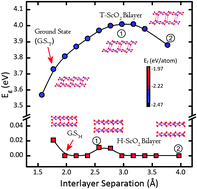Versatile electronic properties of atomically layered ScO2†
Abstract
In recent years, graphene and transition metal dichalcogenides (TMDs) have been at the forefront of candidate materials for next-generation electronic devices. In this study, we will consider transition metal oxides (TMOs), which are a class of materials that can exist in two-dimensional geometries, but exhibit unique properties due to the strong correlation between electrons. Density functional theory calculations under the generalized-gradient approximation with on-site Coulomb interactions (GGA + U) are performed to investigate the (a) geometry, (b) energetics, (c) electronic properties, (d) magnetic properties, and (e) chemical bonding of a layered TMO–scandium dioxide (ScO2) in its octahedral (T) and hexagonal (H) phases. The T-phase is a non-magnetic wide-band gap semiconductor with a band gap of 3.75 and 3.73 eV for the monolayer and bilayer, respectively. The H-phase monolayer is an antiferromagnetic (AFM) metal while the bilayer is metallic and has a ferromagnetic (FM) and an AFM configuration, which degenerate in energy. The metallicity and magnetic coupling between atoms in the H-phase are predominantly governed by the O-pz states. The analysis of the chemical topology using the quantum theory of atoms in molecules (QTAIM) shows that the Sc–O bonds are highly ionic in character. Born effective charge (Z*) analysis suggests that the H-phase monolayer has more uniform chemical bonding. Furthermore, T- and H-phase bilayers respond differently to strain applied normal to the material surface; for the former, the band gap increases and then decreases with the increase of tensile strain, whereas the latter shows a metal → semiconductor → metal transition as a larger tensile strain is applied. The mechanisms for such responses are inherently different in the two phases: in the T-phase, it is due to the shift of the lowest unfilled O-pz band, and in the H-phase, it is attributed to the transformation in shape of the bands close to the Fermi level. The versatility of the electronic properties of ScO2 in its different phases and forms (monolayer and bilayer) can thus be exploited in devices at the nanoscale.


 Please wait while we load your content...
Please wait while we load your content...